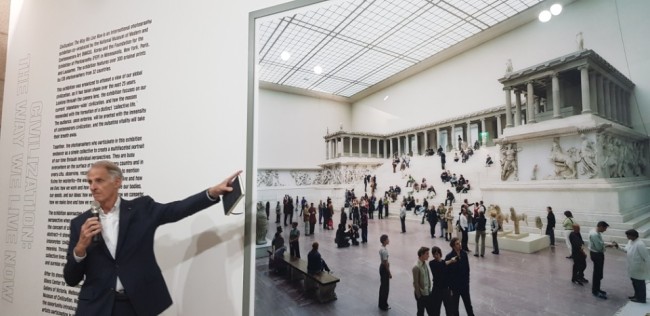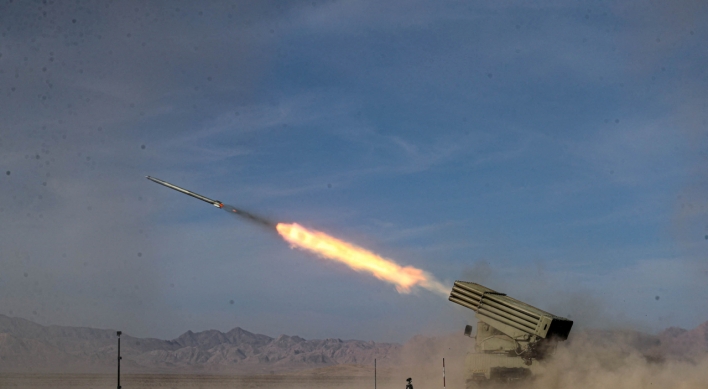Diverse spectrum of contemporary life captured at MMCA
By Shim Woo-hyunPublished : Dec. 16, 2018 - 13:42
(This article was originally published in The Korea Herald's paper on Oct. 23)
A large-scale photo exhibition with the ambitious goal of recording our time on this Earth opened at the National Museum of Modern and Contemporary Art’s Gwacheon branch Thursday, featuring 300 works by 135 artists from 43 countries.
“Civilization: The Way We Live Now,” co-produced by the MMCA and the Foundation for the Exhibition of Photography, offers a broad view of contemporary civilization, just a few decades old, against thousands of years of human history.
A large-scale photo exhibition with the ambitious goal of recording our time on this Earth opened at the National Museum of Modern and Contemporary Art’s Gwacheon branch Thursday, featuring 300 works by 135 artists from 43 countries.
“Civilization: The Way We Live Now,” co-produced by the MMCA and the Foundation for the Exhibition of Photography, offers a broad view of contemporary civilization, just a few decades old, against thousands of years of human history.

The works offer glimpses of the most densely populated cities as well as barren deserts. They show how the world’s complex economic systems operate, and how individuals manage to survive. From leisure scenes to scenes from refugee camps, the selected works portray the different ways people move around the globe.
“Civilization is cumulative. Each generation builds upon the achievements of the past, like an onion, and our own time is like a thin layer,” curator William Ewing said during a press conference held Wednesday at the museum.
Tomas Struth’s 2001 work “Pergamon Museum 1, Berlin” and Richard de Tscharner’s 2010 work “Coexistence dans l’indifference” are two photographs on display at the very beginning of the exhibition that show how the past and the present merge and coexist.
In addition to the cumulative aspect of civilization, the exhibition also focuses on its collective aspect.
“The new planetary-wide civilization is a collective achievement. It requires armies of workers, thinkers and consumers all over the world. But ironically, the collective reality of all our lives is disguised by the cult of individuality,” Ewing said.
The first section, “Hive,” with its images of massive bodies of cities and people, offers a broad sketch of the complexity of the collective reality. The name “Hive” is a reference to Tom Wolfe’s 1987 novel “The Bonfire of the Vanities,” where it represented the frenetic social life of Manhattan in New York City. Another section, titled “Flow,” traces the fast movement of people, products, transportation systems and other things.
On the other hand, the “Alonetogether” section offers a more detailed look into how people live.
The sections “Escape” and “Rupture” illustrate an interesting contrast in the movement of people around the world. Where “Escape” presents photos about tourism -- perhaps the most celebrated form of human travel around the globe -- “Rupture” shows us refugees, who are engaged in another form of travel although it is a tragic one.
The sections “Control” and “Persuasion” allude to the political and cultural forces that regulate people’s lives.
There is a total of eight sections, including the last one, titled “Next.”
The latest exhibition, which highlights the documentary function of photographs, is part of the museum’s efforts to incorporate diverse forms of art into its gallery space, it added.
Following the MMCA run, the exhibition will travel to 10 museums abroad, including the Ullens Center for Contemporary Art in Beijing in March 2019, the National Gallery in Victoria in Melbourne in September 2020 and the Museum of European and Mediterranean Civilisations in Marseille, France, in January 2021.
“The MMCA being the initiator of the project is part of its mandate of being part of global international landscape producer,” said Bartomeu Mari, director of the museum, who is one of the three co-curators of the exhibition, along with Ewing and Holly Roussell Perret-Gentil.
By Shim Woo-hyun (ws@heraldcorp.com)












![[Today’s K-pop] BTS pop-up event to come to Seoul](http://res.heraldm.com/phpwas/restmb_idxmake.php?idx=644&simg=/content/image/2024/04/17/20240417050734_0.jpg&u=)





![[KH Explains] Hyundai's full hybrid edge to pay off amid slow transition to pure EVs](http://res.heraldm.com/phpwas/restmb_idxmake.php?idx=652&simg=/content/image/2024/04/18/20240418050645_0.jpg&u=20240419100350)

![[Today’s K-pop] Zico drops snippet of collaboration with Jennie](http://res.heraldm.com/phpwas/restmb_idxmake.php?idx=642&simg=/content/image/2024/04/18/20240418050702_0.jpg&u=)